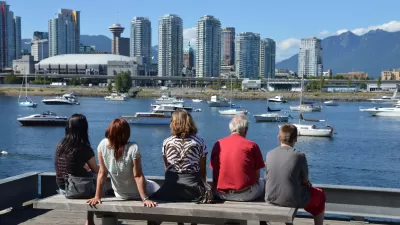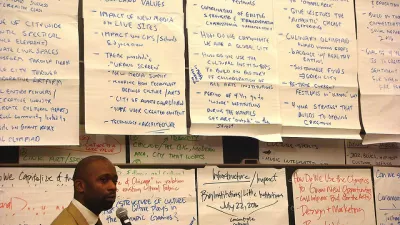In a compelling entry into the public dialog around placemaking, Project for Public Spaces argues that people, rather than merely places, create vibrancy in a community.
As it gears up for the first meeting of the Placemaking Leadership Council in Detroit from April 11-12, planning nonprofit Project for Public Spaces (PPS) has come out with an article clarifying the connection between placemaking and gentrification, the essential elements of a successful placemaking process, and the potential pitfalls of "creative placemaking."
One topic the article tackles is the the rise of the “creative” modifier in the debate around placemaking. Based on a misinterpretation of Richard Florida's Rise of the Creative Class, argues PPS, creative placemaking shifts the emphasis from inclusiveness to exclusivity and competition. Rather than treating cities and neighborhoods as already existing communities, the pitfall of this kind of placemaking is the assumption of a tabula rasa urban condition open to importing community members and economic drivers and causing gentrification. It can also put cities in competition with one another to attract and retain a creative workforce rather than focusing on improving local resources.
While identifying the typical markers of vibrancy as active art and music scenes and plenty of restaurants, PPS argues that ultimately "people are vibrancy" and that the most important provision of placemaking is a forum for ongoing community conversations, not simply the best place to have gelato.
FULL STORY: Placemaking: Shared focus on place builds vibrant destinations

Alabama: Trump Terminates Settlements for Black Communities Harmed By Raw Sewage
Trump deemed the landmark civil rights agreement “illegal DEI and environmental justice policy.”

Study: Maui’s Plan to Convert Vacation Rentals to Long-Term Housing Could Cause Nearly $1 Billion Economic Loss
The plan would reduce visitor accommodation by 25% resulting in 1,900 jobs lost.

Planetizen Federal Action Tracker
A weekly monitor of how Trump’s orders and actions are impacting planners and planning in America.

Wind Energy on the Rise Despite Federal Policy Reversal
The Trump administration is revoking federal support for renewable energy, but demand for new projects continues unabated.

Passengers Flock to Caltrain After Electrification
The new electric trains are running faster and more reliably, leading to strong ridership growth on the Bay Area rail system.

Texas Churches Rally Behind ‘Yes in God’s Back Yard’ Legislation
Religious leaders want the state to reduce zoning regulations to streamline leasing church-owned land to housing developers.
Urban Design for Planners 1: Software Tools
This six-course series explores essential urban design concepts using open source software and equips planners with the tools they need to participate fully in the urban design process.
Planning for Universal Design
Learn the tools for implementing Universal Design in planning regulations.
Caltrans
Smith Gee Studio
Institute for Housing and Urban Development Studies (IHS)
City of Grandview
Harvard GSD Executive Education
Toledo-Lucas County Plan Commissions
Salt Lake City
NYU Wagner Graduate School of Public Service




























